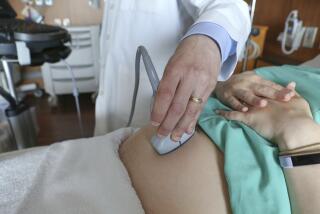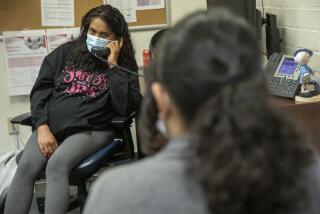Study Assails County’s Medical System for Poor
- Share via
In a devastating indictment of Los Angeles County’s medical system for the poor, a private study has concluded that the county’s six hospitals and 47 health centers are so poorly funded and understaffed that the quality of care is “unacceptable by any standards of availability and quality.”
The report said needless deaths probably are occurring in the county as a result.
Delivered to the Board of Supervisors and the Department of Health Services on Thursday, the report was prepared for the Legal Aid Foundation of Los Angeles, which long has been critical of the county’s system of providing medical care to the indigent.
The report’s conclusions are based on interviews conducted by the survey staff with more than 50 county physicians, nurses and health workers, as well as on telephone calls made to health centers seeking appointments on behalf of hypothetical patients with several common medical complaints.
Shocking Commentary
The report contains many of their candid observations--and sometimes shocking commentary--on the system.
At Harbor/UCLA Medical Center, for instance, nurse Sandra Delahoussaye said: “Patients die or become inoperable while waiting for our surgical services. . . . People that a private doctor would operate on in one day, wait three to four weeks.”
At the same hospital, according to Dr. Mark Goldberg, head of neurology, a woman admitted with a brain tumor sat in the emergency room for 17 hours complaining of blurred vision before a doctor saw her and realized that she needed to see a neurologist.
The report also found that barely half the pregnant women had any prenatal care at all during the crucial first trimester. It said those with high-risk pregnancies often must wait four hours for a five-minute visit.
Patients seeking care at County-USC’s tumor clinic face waits of up to two months before getting a liver or lymph node biopsy, according to a physician’s assistant in the hospital’s emergency room. Delays in obtaining appointments in all specialty clinics, another physician said, resulted in a “substandard and dangerous” situation for patients because they routinely are lost to follow-up care.
No Beds Available
Emergency-room care was no better, according to the report. At Martin Luther King/Drew Hospital, it said, walk-in patients regularly must wait an average of six to eight hours. And an emergency room doctor there said it is not unusual for critically ill patients to be kept in the emergency room for 24 hours because no suitable beds are available.
“We regularly have heart attack patients held for 36 to 46 hours in the ER (emergency room) waiting room for (intensive care unit) beds,” Harbor/UCLA’s Goldberg said.
The 132-page report was prepared by Geraldine Dallek, a health policy consultant to the foundation, and E. Richard Brown, an associate professor at the UCLA School of Public Health.
A spokesman for Robert C. Gates, the director of county health services, said Gates was not in a position to immediately respond to the report. Spokesmen for several of the supervisors said they had not yet read the report and declined to comment.
First-Hand Accounts
The report is peppered with first-hand accounts of medical personnel working under adverse conditions because of staffing shortages, rising patient loads, insufficient or obsolete equipment and long delays at receiving the results of laboratory tests.
State law makes counties responsible for providing health care to their indigent population. And although the law requires the availability and quality of the services to be “the same as that available to non-indigent people receiving health care services in private facilities in that county,” physician after physician in the report declared that the quality of services in his or her unit is not comparable to the private sector.
In the last 10 years, the Legal Aid Foundation, a nonprofit law firm that provides civil legal assistance to the poor, has filed four lawsuits against the Board of Supervisors on the issue of health care for the poor. As a result of one such case, a Los Angeles County Superior Court judge in May ordered the Board of Supervisors to detail the budgetary cuts it had intended to implement that would affect health care for the indigent. The county had proposed a $55-million cut in funds for health services for 1987-88.
Proposed Cuts
The detailed proposed cuts, the county has now disclosed, would result in the closing of more than 1,100 beds, the elimination of more than 48,000 monthly outpatient visits, and other cuts that would affect about 21,000 patients per month.
The report said further cuts would have devastating consequences for the system that already is overburdened.
For example, at Women’s Hospital, where occupancy rates have reached 110%, an unnamed physician said: “We are so overcrowded that babies sometimes are delivered in the hallways. If we have a number of Caesarean-sections at one time that occupy the residents, only an unsupervised intern is on the floor to deliver babies.”
Dr. Michael Criley, a Harbor/UCLA cardiologist, said: “For new patients . . . we have a waiting time of three to four months. . . . Because of the patient load, we reschedule people who should be seen every one to two weeks at six-month intervals.”
Also at Harbor/UCLA, Dr. Margaret Yonekura, chief of obstetrics, said: “It is difficult for a doctor to explain to a woman’s family that in a private hospital this patient would live, but in a county hospital she will die.”
She added: “It is difficult to explain to yourself when you know that, with the proper facilities, you could have saved her life.”
The report also cited a UC-Santa Barbara report that says County-USC Medical Center and Martin Luther King/Drew Medical Center have the worst perinatal death rates in California. And at Women’s Hospital, patients seeking prenatal care often are “forced to wait several weeks for appointments,” nurse Roberta Villanueva said. Another nurse, Margaret Terrones, recalled that a pregnant woman with an abnormal PAP smear who tried to get a prenatal visit appointment was turned away because she did not have the required $30.
Citing another example of the overburdened conditions, an unidentified nurse at the San Fernando Valley Health Center said it is not uncommon for pregnant women to faint because of the lack of air conditioning.
‘Refuse People’
A nurse at the El Monte Comprehensive Health Center said that “we can only accept 50 patients for immunizations every day. By 7 or 7:30 a.m., the patients are lined up. Every day we have to refuse people.”
Goldberg, the Harbor/UCLA neurologist, said that “increasingly we are unable to admit people who should be admitted. A (non-emergency) admission is almost impossible. . . . It is not uncommon for patients to come in two or three times before they are admitted.”
As part of the study, the researchers telephoned county health centers seeking appointments for two hypothetical patients: a 53-year-old woman with a lump in her breast and a 48-year-old male with high blood pressure. According to standard medical practice, each should be seen by a doctor within two weeks.
Of the four comprehensive health centers called for the first patient, no appointment was available at the Roybal center for almost six weeks and at El Monte for almost 10 weeks. The caller could not get through to the Humphrey Comprehensive Center because of a busy signal and gave up after three tries. An appointment was obtained only at the Hudson center.
Of six centers contacted for the high blood pressure condition, only two were able to provide an appointment within two weeks.
Staff Called ‘Heroic’
Bruce G. Iwasaki, an attorney with the foundation, said that while the report raises disturbing questions, it was not meant to be a criticism of those working in the system, whom he called “heroic.”
But, as the report noted, “despite the dedication of county staff, conditions at county hospitals and health centers are getting worse, not better. The system is under siege.”
Statistics in the report indicated that about four-fifths of those who use county health facilities are poor and are either on Medi-Cal, the federal and state-funded program for indigents, or are uninsured.
More to Read
Sign up for Essential California
The most important California stories and recommendations in your inbox every morning.
You may occasionally receive promotional content from the Los Angeles Times.













